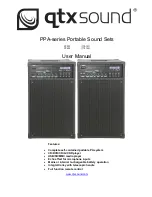
Zaxcom Digital Wireless System User’s Manual_______________________________________Chapter 6
61
Setting up the IFB100
This section describes setting up the IFB100 for the first time.
Power Requirements
The IFB100 requires an external power source (8 to 18 VDC). Ideally, the source should be 12 VDC. Normal
current draw is 125 mA at 12 VDC but a power supply needs to be capable of supplying at least 1 amp.
Audio Input
The two channel balanced audio input on the IFB100 has a TA-5M connector. The input audio range is -8 dBu to
+4 dBu. You can configure the IFB100 to transmit a single channel or a mix of the two input channels.
Adjusting the Input Audio Level
The input audio level is preset by Zaxcom at +4 dBu. However, this level can be adjusted using the trim pots
located on the outside of the unit. See the Side View in
Fig 6-1
.
Timecode
Unless an external timecode source is present, the IFB100 outputs free-run timecode. When connected to an
external timecode source, the timecode generator syncs with it.
IMPORTANT:
A stereo plug is required for external timecode sync. Do
not
connect to the ring on the plug.
You cannot use a mono plug.
A mono plug will not destroy any components but it will short out the signal.
IFB100 Configuration Menus
The IFB100 uses a series of menus for configuration. These menus are similar to other Zaxcom wireless devices
and behave in a similar fashion.
There are nine
Standard
and thirteen
Extended
menu pages, as follows:
Standard Menu
Extended Menu
Pacifier page
Highpass Filter page
Remote Audio Gain page
Limiter page
Remote Unit ID page
IFB Format page
Remote Audio Freq Chg page
IFB Frequency page
Remote Power Setting page
Power-up Mode page
Timecode Frame-rate page
Timecode Jam Mode page
IFB Frequency page
Timecode Source page
IFB Input Mix page
Timecode Output Enable page
Lock page
Remote Control Group ID page
Remote Control Unit ID page
IFB Tx Power page
TV Channel Minimum page
TV Channel Maximum page
Table 6-1 IFB100 Standard & Extended Menus
Each time the
MENU
key is pressed, the menu advances to the next page, in sequence.
















































